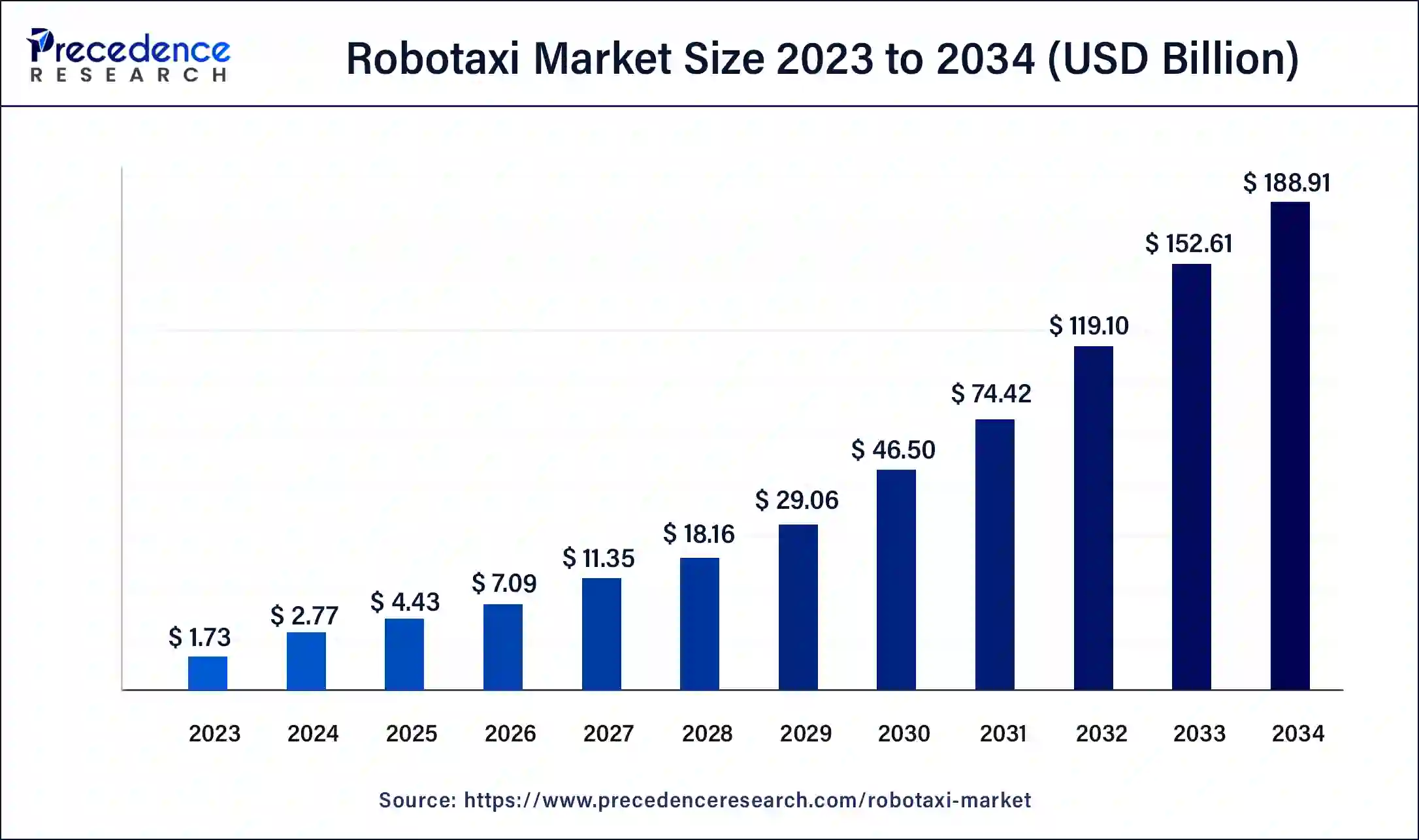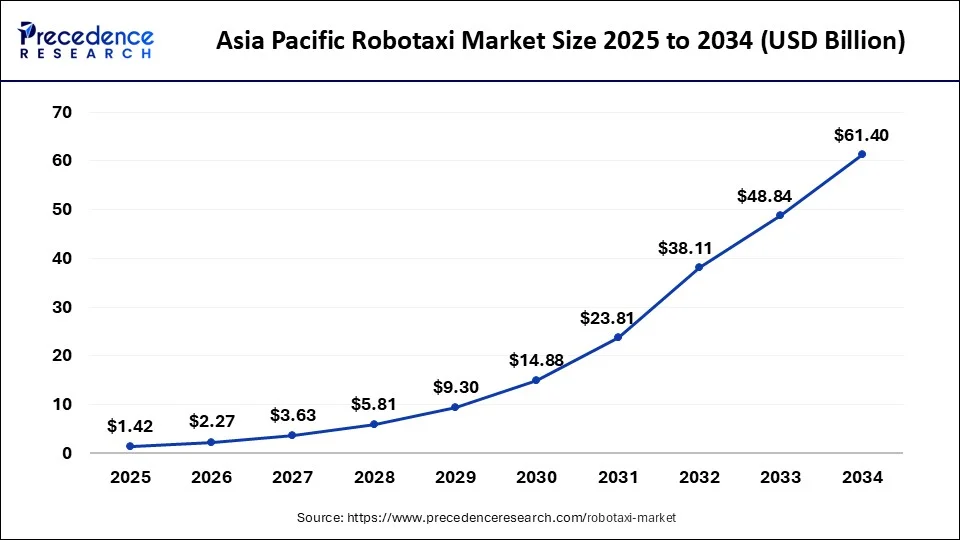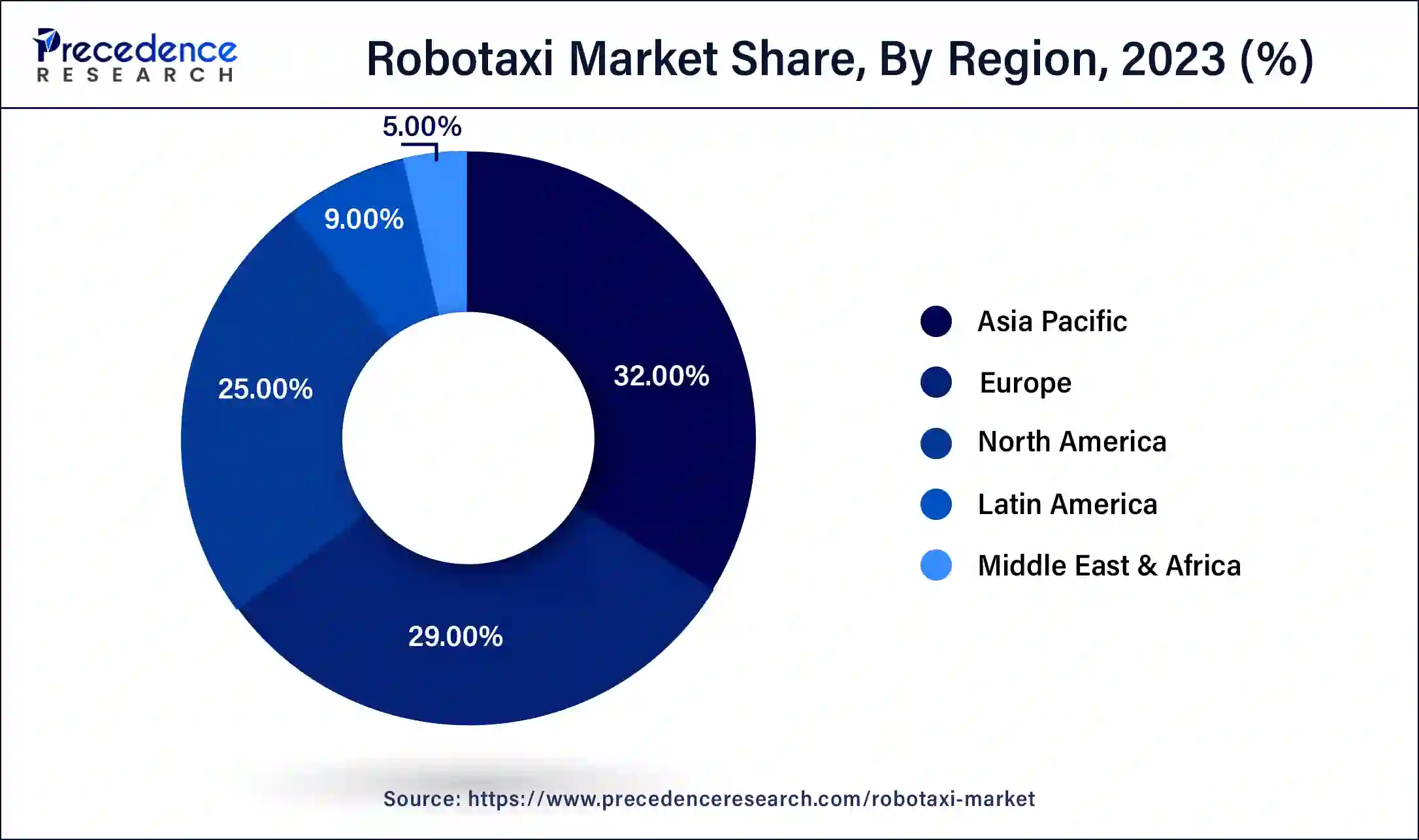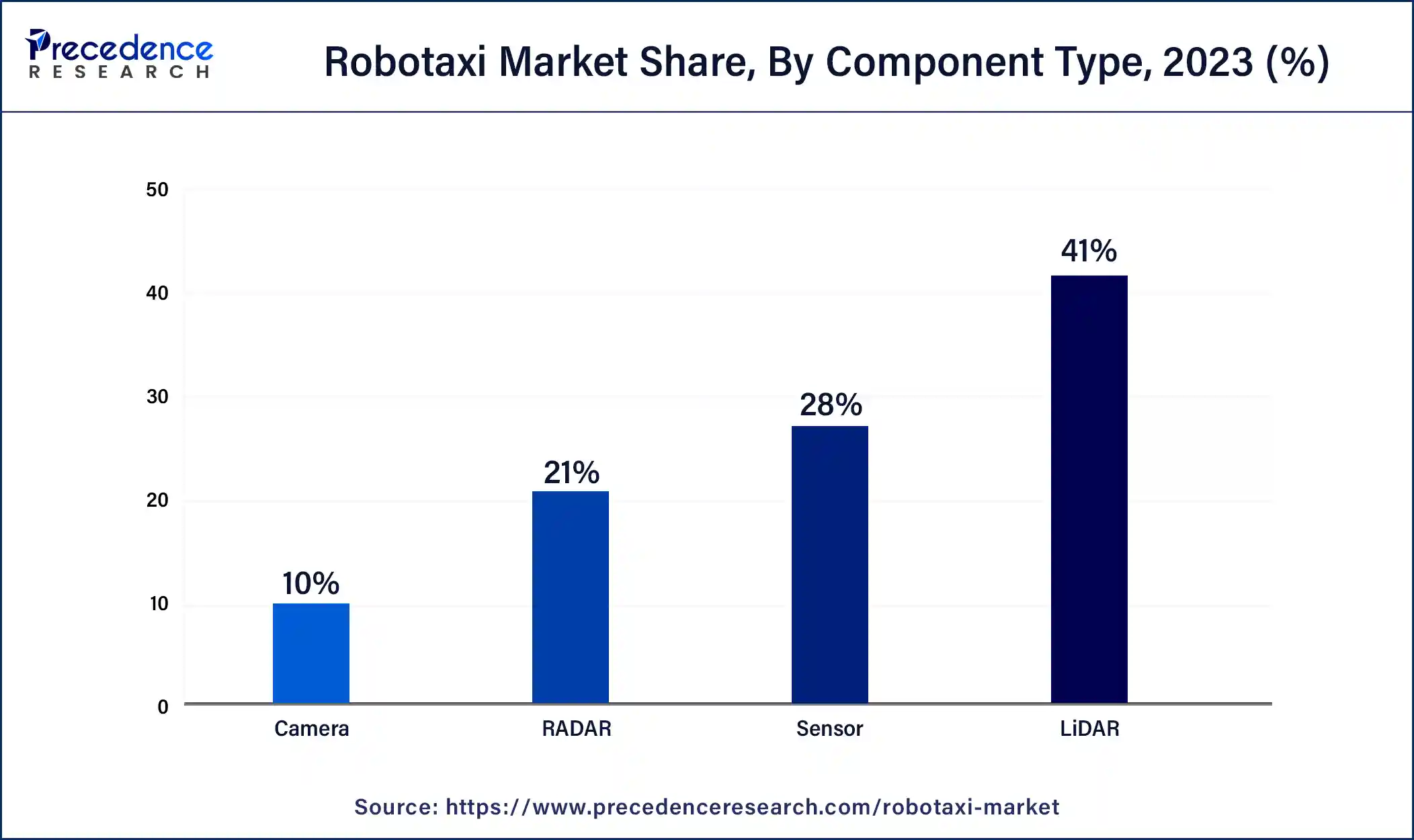List of Contents
Robotaxi Market Size and Forecast 2025 to 2034
The global robotaxi market size was estimated at USD 2.77 billion in 2024 and is predicted to increase from USD 4.43 billion in 2025 to approximately USD 188.91 billion by 2034, expanding at a CAGR of 52.54% from 2025 to 2034. The rising need for safety in transport is one of the biggest contributors to the robotaxi market growth. This drives significant attention towards improvement in the public transport sector.

Robotaxi Market Key Takeaways
- In terms of revenue, the global robotaxi market was valued at USD 2.77billion in 2024.
- It is projected to reach USD 188.91 billion by 2034.
- The market is expected to grow at a CAGR of 52.54% from 2025 to 2034.
- Asia Pacific dominated the global robotaxi market with the largest market share of 32% in 2024.
- Europe is expected to grow significantly in the market during the forecast period of 2025 to 2034.
- By propulsion type, the electric vehicle segment stood the dominant in the market in 2024 and is expected to maintain its dominance during the forecast period.
- By component type, the LiDAR segment held the largest market share of 41% in 2024.
- By component type, the RADAR segment is anticipated to register rapid growth in the market during the forecast period of 2024 to 2034.
- By application, the passenger segment accounted for the largest share of the market in 2024.
- By application, the goods segment is expected to grow at the highest CAGR in the market from 2025 to 2034.
How Does AI Help in the Robotaxi Market?
The rapid adoption of technologies like AI has been playing a key role in the growth of the robotaxi market. AI has a key role in enhancing the safety of these taxis by navigating obstacles and complex traffic conditions, which protect the taxi from other vehicles. AI can analyze huge data patterns, which will help navigate routes and optimize them. AI has made a major contribution to developing autonomous vehicles by interpreting huge datasets that track consumer preferences and help in coming up with a more customer-centric approach.
- In December 2022, Cruise Automation expanded its driverless robotaxi service to Austin, Texas, and Phoenix, Arizona, following its initial launch in San Francisco earlier that year.
Asia Pacific Robotaxi Market Size and Growth 2025 to 2034
The Asia Pacific robotaxi market size was evaluated at USD 0.89 billion in 2024 and is predicted to be worth USD 61.40 billion by 2034, expanding at a CAGR of 52.71% from 2025 to 2034.

Asia Pacific dominated the global robotaxi market in 2024. Countries like China, South Korea, and Japan are investing heavily in automation in the transport sector. These countries also have a well-established road infrastructure, and they are focusing on adopting robotaxis. The region also contains the fastest urbanization in countries like India, Japan, and China, which has been a major attraction for adopting robotaxi services.

Europe is expected to grow significantly in the robotaxi market during the forecast period of 2024 to 2034. The growth of the region is attributed to increasing awareness regarding the safety issues in the transport sector. The UK government is focusing on autonomous transport services which provide cost-effective services to the patients. EVs are the major factor that promotes these taxi services and the region is adopting EVS heavily to meet the sustainability goals and adopt clean transportation. European companies are also investing heavily in the promotion of autonomous vehicles.
- Germany became the first country to authorize Level 4 autonomous vehicles on public roads, with Mobileye praising the new law that allows self-driving cars without a human backup driver
Market Overview
Robotaxi refers to an autonomous self-driving vehicle operated without any driver intervention. These taxis are developed using advanced technologies that play a key role in ensuring smooth customer service by transporting passengers or goods from one location to another. These taxis include several components like sensors, cameras, navigating systems, and technology like AI, which are used for making robotic taxis. The robotaxi market is gaining significant popularity as it helps reduce traffic and congestion by following the rules and maintaining the lanes. This also leads to controlled use of the fuels, which play a vital role in maintaining environmental norms.
Some cities in the United States, like New York, San Francisco, and Washington, have a higher travel time than the other cities, which makes the adoption of robotaxi market service a better option and help in reducing the time required for traveling.
Average Time Travel Per 10 KM in the U.S.
| City | Average time travelled (in minutes) |
| New York | 25 |
| Washington | 21 |
| San Francisco | 21 |
| Boston | 19 |
| Chicago | 18 |
| Baltimore | 18 |
| Seattle | 16 |
| Philadelphia | 16 |
| Los Angeles | 15 |
| Miami | 15 |
Robotaxi Market Growth Factors
- The rising consumer shifts towards automation stand out as a major growth factor for the robotaxi market.
- The rising focus on infrastructure development is one of the major contributors to the market growth.
- The rising urbanization is leading to automation in the transport sector, which influences different industries to adopt robotic taxis.
- The advancing technologies in the market have been constantly focusing towards enhancing transportation safety which stands out as a major growth factor.
Market Scope
| Report Coverage | Details |
| Market Size by 2034 | USD 188.91 Billion |
| Market Size in 2025 | USD 4.43 Billion |
| Market Size in 2024 | USD 2.77 Billion |
| Market Growth Rate from 2025 to 2034 | CAGR of 60.03% |
| Largest Market | Asia Pacific |
| Base Year | 2024 |
| Forecast Period | 2025 to 2034 |
| Segments Covered | Propulsion Type, Application, Component Type, and Regions |
| Regions Covered | North America, Europe, Asia-Pacific, Latin America and Middle East & Africa |
Market Dynamics
Drivers
Cost efficiency of robotaxi services
Robotaxis operated without any human intervention are a major attraction for public transport companies like Uber and Ola. These services eliminate the need for drivers, which saves them labor costs and helps increase their profit margin. Additionally, the vehicles' technologies can predict maintenance updates, which can also play a crucial role in saving additional costs. The rapid shift towards the urban lifestyle has generated a need for 24/7 transport services, which stands out as a driver of the robotaxi market.
Increasing traffic congestion
There are several concerns regarding congestion in many countries due to the unavailability of proper road infrastructure. Autonomous robotic taxis have features that can analyze the routes and help in enhancing the routes, which can be a time saver for individuals. The robotaxi market also helps manage traffic and reduces sound pollution. Additionally, a rise in pedestrian traffic is observed.
Restraints
Limited public acceptance
Robotaxi services have started to shine in developed regions, but there are factors that restrain the growth of the robotaxi market. There are safety concerns about autonomous vehicles due to the lack of technological awareness in underdeveloped regions. This leads to the spread of misinformation in these regions, which increases the reliability of human-controlled transport.
Opportunity
Increasing regulatory support
Many governments are focusing on increasing the adoption of technologies like artificial intelligence (AI) and machine learning in the transport sector, which enhances autonomous vehicles and expands their use all over the region. The potential in the advancement of the robotaxi market has led to multiple investments which are gaining the trust of the public.
Environmental Regulations
The robotaxi market products are majorly ruined by electric vehicles the rising adoption of these vehicles to reduce the environmental effect is leading towards the focus of the governments which provides incentives to the people purchasing EVs. Many transport companies are also adopting the use of EVs.
Propulsion Type Insights
The electric vehicle segment stood the dominant in the robotaxi market in 2024 and is expected to maintain its dominance during the forecast period. These vehicles are powered by electric energy, which is considered eco-friendly as it eliminates pollution. Many governments are promoting the use of EVs by implementing policies that eliminate pollution; they have also adopted EVs in their public transport facilities. Robotic EV taxis are gaining popularity as they can be run at lower costs, which is preferable in the long run. Fueling of the vehicle becomes a major factor that influences its use in public transportation. The segment is expected to maintain its dominance during the forecast period of 2024 to 2034. The rapid growth of EVs in robotaxis is attributed to the increasing focus on the expansion of the charging infrastructure, which improves connectivity, especially in underdeveloped regions. The rising sustainability trend also becomes a crucial factor influencing individuals toward clean transportation.
- In January 2024, Rimac announced Verne, its ambitious project to develop a fully autonomous EV robotaxi, set to debut in Zagreb in 2026 with a focus on a fully personalized passenger experience and a groundbreaking, driver-free platform.
Component Type Insights
The LiDAR segment held the largest share of the robotaxi market in 2024. Light detection and ranging (LiDAR) in the market is a remote sensing method that uses laser light to measure distance and calculate the whole environment around the vehicle. These sensors scan the area and help emit any potential risks like obstacles, pedestrians, etc., which harm the vehicle or the passenger. The dominance of the segment is attributed to the accuracy of these laser-emitting technologies, which have the potential to function in complex environments. These factors become a perfect match for fully automated vehicles, which are to be run without human intervention.
- In September 2024, Honda announced an investment in SiLC Technologies to advance FMCW lidar and AI-based machine vision for safer and more reliable autonomous vehicles.

The RADAR segment is anticipated to register rapid growth in the robotaxi market during the forecast period of 2025 to 2034. RADAR in the market is the use of radio waves to detect the movements of the objects around the vehicle. The growth of the segment is attributed to its capability to detect large obstacles in harsh weather conditions. These systems are gaining popularity in commercial use as they are cost-effective and can perform in certain conditions. These can be helpful in cold conditions and frequently witness wind and fog. These benefits are gaining attraction, which is resulting in more focus and investments toward the adoption of RADARs.
- The 2025 Toyota Sienna introduces a standard Advanced Rear Seat Reminder using a 60GHz radar sensor to detect rear seat movement, offering escalating alerts and optional app notifications through Safety Connect.
Application Insights
The passenger segment accounted for the largest share of the robotaxi market in 2024. The segment includes the transportation of passengers from one place to another. The changing lifestyles and schedules have increased the demand for public transport, which provides them safe services. Many companies that are into public transport are focusing on adopting these taxis, which will help them reduce their costs. The increasing population in developing have raised the need for convenient transport options. Companies that provide transport services also help the robo-tai market grow. Many professionals choose public transport to avoid traffic and save travel time.
The goods segment is expected to grow at the highest CAGR in the robotaxi market from 2024 to 2034. The goods segment in the robotaxi market refers to the use of these vehicles for transporting various logistics in these vehicles. The changing lifestyle dynamics have raised the demand for home delivery options. There has been a global shift towards the use of e-commerce, which has led to increasing competition in the business environment.
Robotaxi Market Companies
- Tesla Inc. (U.S.)
- Uber Technologies Inc. (U.S.)
- Baidu (China)
- Waymo LLC (U.S.)
- Aptiv (Ireland)
- Didi Chuxing Technology Co (China)
- Zoox, Inc (U.S.)
- AutoX, Inc (U.S.)
- Cruise LLC (U.S.)
- Lyft, Inc (U.S.)
Recent Developments
- In September 2024, Foster City-based Zoox announced that they are entering the Bay Area robotaxi market with uniquely designed autonomous vehicles, featuring inward-facing seats and dual-side doors, aiming to differentiate itself from traditional robotaxi models.
- In July 2024, Waymo secured a USD 5 billion investment from Alphabet, accelerating its lead in the self-driving taxi industry.
- In November 2023, Hyundai Motor Group and Motional announced the manufacture of the all-electric IONIQ 5 robotaxi at the new Hyundai Motor Group Innovation Center Singapore, with initial models set for U.S. deployment in 2024.
Segments Covered in the Report
By Propulsion Type
- Electric Vehicle
- Hybrid Electric Vehicle
- Fuel Cell Vehicle
By Application
- Passenger
- Goods
By Component Type
- LiDAR
- RADAR
- Camera
- Sensor
By Geography
- North America
- Asia Pacific
- Europe
- Latin America
- Middle East & Africa
For inquiries regarding discounts, bulk purchases, or customization requests, please contact us at sales@precedenceresearch.com
Frequently Asked Questions
Ask For Sample
No cookie-cutter, only authentic analysis – take the 1st step to become a Precedence Research client